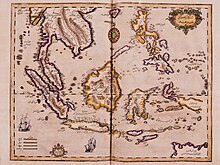Kâtip Çelebi
| Kâtip Çelebi | |
|---|---|

This map of the Indian Ocean and the Chinese Sea was engraved in 1728 by the Hungarian-born Ottoman cartographer and publisher Ibrahim Müteferrika; it is one of a series that illustrated Katip Çelebi's Universal Geography, the first printed book of maps and drawings to appear in the Islamic world.
|
|
| Born |
Mustafa bin Abdullah February 1609 Constantinople, Ottoman Empire (now Turkey) |
| Died | 26 September 1657 Constantinople, Ottoman Empire |
| Other names | Haji Kalfa, Hacı Halife |
| Occupation | Historian, geographer |
Kâtip Çelebi (Ottoman Turkish: كاتب چلبى, Kātib Çelebi "Gentleman Scribe"), the pen name of Mustafa bin Abdullah (1609–1657), also later known as Haji Khalifa (Turkish: Hacı Halife) or Kalfa, was an Ottoman scholar. A historian and geographer, he is regarded as one of the most productive authors of non-religious, scientific literature in the 17th-century Ottoman Empire.
Kâtip Çelebi was born as Mustafa, the son of an Abdullah, in Istanbul. He began his studies at the age of five or six, and became an apprentice in the Ottoman financial bureaucracy at the age of fourteen. As the accountant of the commissariat department of the Ottoman army in Anatolia, he accompanied the Ottoman army in the suppression of the rebellion of Abaza Mehmed Pasha in 1624, as well as during the Ottoman-Safavid War of 1629-1639, particularly in the campaigns at Baghdad in 1625, and at the siege of Erzurum. He returned to Constantinople in 1628. In the following year he was again in Baghdad and Hamadan, and in 1633-34 at Aleppo, whence he made the pilgrimage to Mecca (hence his title Hajji). The following year he was in Erivan and then returned to Constantinople. Here he obtained a post in the head office of the commissariat department, which afforded him time for study. An inheritance which he received in 1645 enabled him to live comfortably in the Ottoman capital of Istanbul and dedicate his time to scholarship. Katip Çelebi died untimely in 1657.
Many of his works were composed between 1648 and his death in 1657. Among his best-known works is the Kashf al-ẓunūn ‘an asāmī al-kutub wa-al-funūn, (كشف الظنون عن أسامي الكتب والفنون) ("The Removal of Doubt from the Names of Books and the Arts"), a bibliographic encyclopaedia, written in Arabic, which lists more than 14,500 books in alphabetic order.
...
Wikipedia
